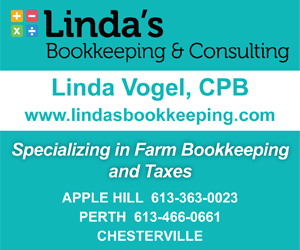Usually, people who run a business have a business and personal life, often two distinctly different realities.
For farmers across Ontario, the farming business is also their lifestyle.
When a farmer’s costs go up and down, when the value of their harvest is affected by global or political events or when the weather turns on them, they have to be able to deal with that reality.
Getting it right the first time for a farmer is not unlike a carpenter saying, measure twice and cut once. Mistakes in planting and harvesting strategies are not always easy to forgive and have a tremendous impact on a farmer’s business and consequently lifestyle.
However, being prepared for the worst yet ready to accept the best has become a standard agricultural way of thinking.
This year crop prices are in a good place in a volatile market, and all of that good planning has paid off for many farmers.
Ontario exports half of beef/cattle, 70 per cent of its soybeans, 70 per cent of its pork, 75 per cent of wheat, 90 per cent of its canola and 95 per cent of its beans or pulses. Over 90 percent of Canada’s farmers are dependent on exports as well as about 40 percent of our food-processing sector.
Almost all the barley grown in Ontario is used for feed and stays in the province with about one per cent exported.
Markus Haerle is a director with the Grain Farmers of Ontario and owns a farm just outside of Ottawa.
The Haerle family farm grows a variety of produce including small grains, corn, oilseeds, soybeans and spring wheat. The operation also includes eggs from its egg-laying hens.
Haerle said there is currently a shift in pricing of food going on.
“There is actually a big correction going on now in the pricing. A lot of that so called good future outlook might degrade very quickly,” he said.
‘The weather situation around the world has had an impact.”
“There is a lot more drought in the United States. But in the southern United States they are getting rain right when they need it, and they have already started harvesting wheat. Corn will be next in a month and a half. It is looking favourable for them,” he said.
“It puts a bit of security behind the volatility. So that means that pricing will go down based on the security of a crop.”
The price of products is based on several factors including expectations, speculation in the market and what the rest of the world is eating and buying from farmers.
“Local demands can have a little bit of an impact, but imports are sometimes over flooding local products as well,” said Haerle.
“Importing grain now-a-days is not a big deal for big companies. They just call up a large broker, load it somewhere in the United States, South America or from somewhere around the world and it gets brought in and ends up in Cardinal or Johnstown, it can end up in Hamilton. It is unloaded and there you go; the market is flooded.”
Farmers often get contracts for a product they have not planted yet which means both grower and buyer are agreeing on a price based on market experience, anticipated demand and predictable weather.
Even with crop insurance which will pay up to 90 per cent of a farmer’s production if called upon there is still a risk.
Using insurance does not make a profit for a farmer but at least allows him or her to keep going, and plan for the next year.
Haerle said that now the market is correcting itself by lowering prices because all of the factors affecting the prices are looking good.
“But another weather scares of drought or severe flooding in a large production area it can go back up,” he said.
Now higher input costs for a farmer are helped by higher prices however that can change in an instant.
“If you take the increase in commodity pricing in the last six months, it is roughly a 30 to 40 per cent increase. But now we have already seen an increase of five to 10 per cent in costs this year in 2021,” he said.
“We have to be so efficient with what we do to be able to remain in business,” said Haerle.
Erin Leduc, owner of Wanna Make it Farms in Moose Creek, Ontario operates a commercial grain elevator, a trucking business, and an excavation business.
She said since farmers base future earnings on the current cost of production, they can profit when costs stay consistent and prices for their products go up.
“If people are forward contracting next year, there [are] going to be better margins again,” she said.
She said farmers are not able to control much of their own destiny as far as prices are concerned, because usually prices are determined by members of the food supply chain that operate at a different level than the average farmer.
“I think it is like everything. Farmers have always had a certain limit on their potential on what they can make with traditional commodities,” said Leduc;
“it’s like any business, you can only afford to make so many mistakes.”
Leduc admitted that while the make is very volatile it is also very positive right now.
“It makes it very challenging, and I think a lot of people are second guessing their decisions.” Leduc suggested that those farmers who did not take on contract’s may far better for the moment.
She thinks that on average, farmers will come out a bit ahead since their expectations were based on last year’s experience and this year the market has increased the value of their products.
Greg Vanden Bosch of Vanden Bosch Elevators in Chesterville said, “It’s pretty much a demand driven rally we have been seeing since last fall.” He feels that has influenced the market.
“There have been some supply chain disruptions over the course of last year that definitely helped.”
He feels weather and politics are definitely a factor in how the market moves.
“You can work around the weather and work around everything else, but as for the market, the market is going to go where the market is going to go,” he said.
For the moment, expectations for next year’s crop are not as high as this year but are still 10 to 15 per cent higher than normal.












